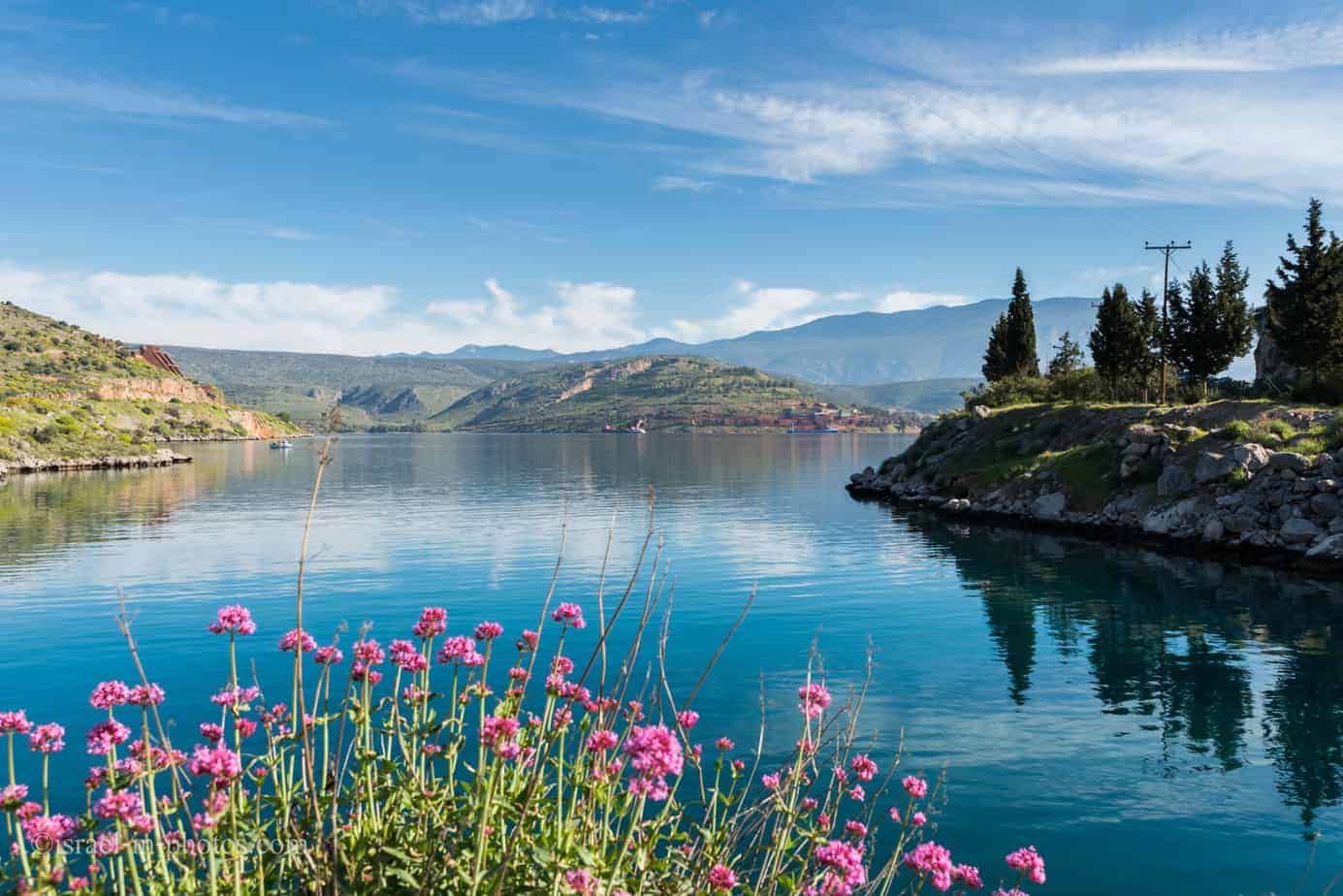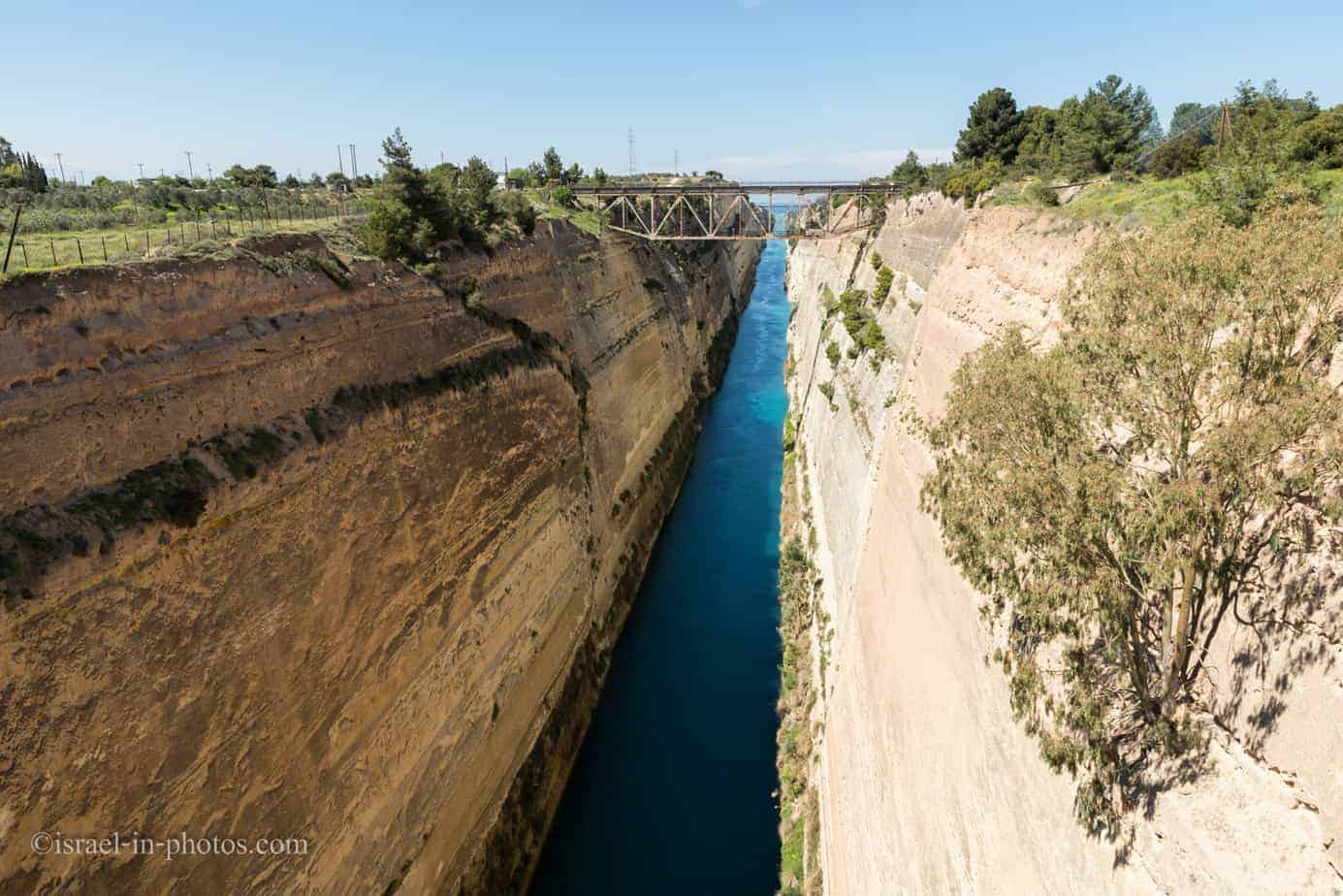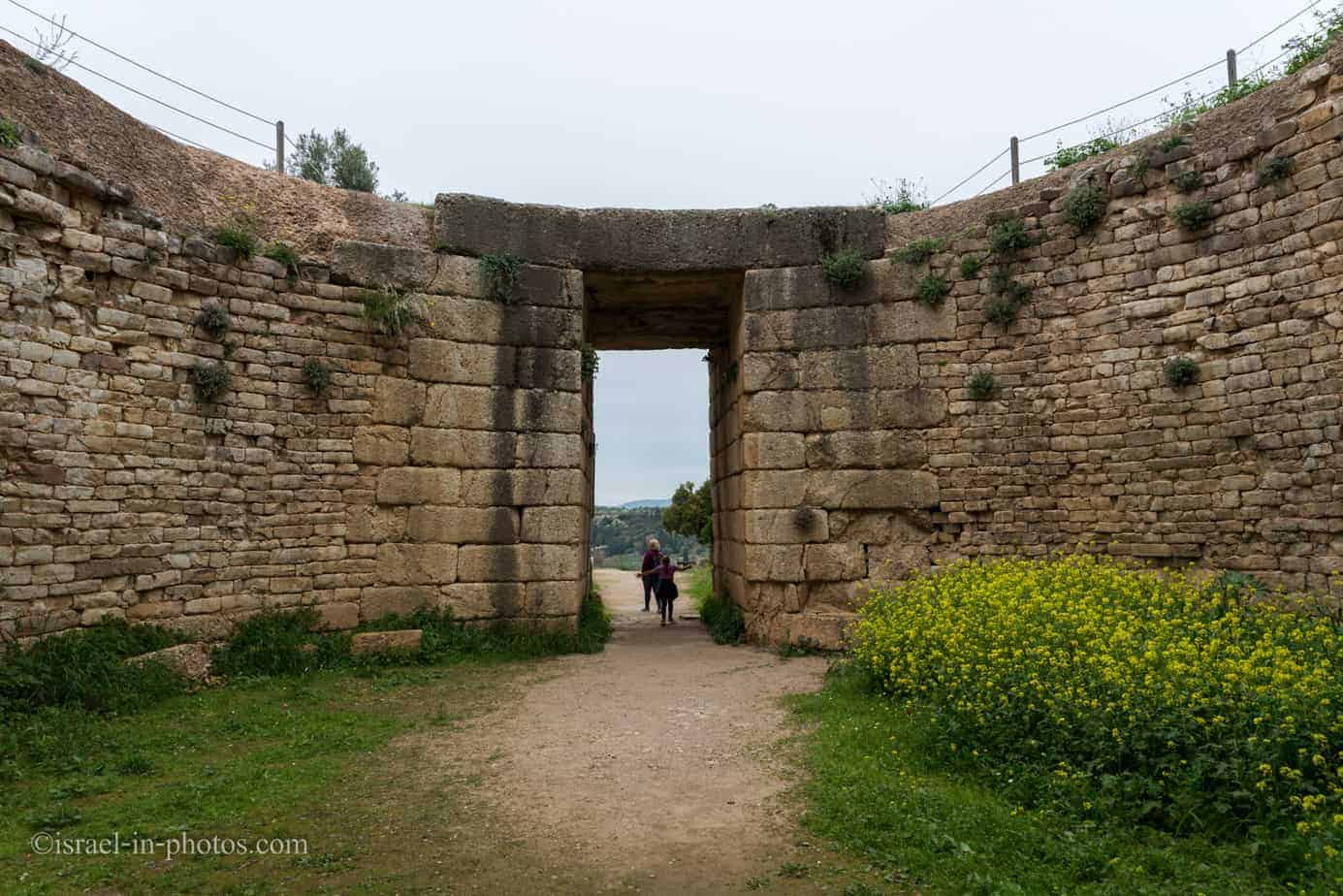A Week In Central Greece
During Passover, we visited Greece for one week. Our trip consisted of three days in central Greece (not far from Athens) and three and a half days in Athens. Moreover, we traveled with my daughter, who is in the first grade. Because of this, and the fact we wanted to rest, the trip was at a slower pace. Also, I should mention that for the first three days we had a rental car.
In this post, I will share our experiences and what I learned during and before the Greece trip.
Table of Contents
Map
Before every trip, I create a plan in Google Maps. Then I place all attraction on this chart. That makes route planning easier. And here is my map of Greece.
Attractions Map of Greece:
Visiting Islands
Our flight was to Athens airport. And as you can see, the islands are not close to Athens. After checking different options, I got to a conclusion that we will do island hopping in another trip. There are two options for visiting the islands. A boat trip that takes from 8 to 14 hours (depending on the island and the boat). And a flight that takes less than two hours. But if you add the time it takes to arrive at an airport and all checkups, it will take at least half a day. Moreover, the flights are not cheap and cost around 200 USD per person.
The option I was looking for was a night sail (so that you will not lose one day on the way), but I have not seen such cruises. Considering we did not want to spend much time on the road to the islands, we decided to skip them altogether.
Following the previous principal, of finding nearby attractions, we decided to visit places not far from Athens, like Delphi and Mycenae.
In the beginning, I will share some general info, things I learned before and during the trip and then we will go over our route.
Transportation
Car
I heard many complaints about driving in Greece. And read different driving survival guides online. But as it turned out, overall I did not have any bad experiences.
And in many cases, you will read about the negative side of driving. Since people tend to tell about the extremes (either positive or negative) and not the average. But there are two things I ought to mention.
Before getting to it, I wanted to say that the roads are quite good and similar to what you find in other EU countries.
Car Size
After reading an article “Survival on the Greek Roads“, I decided to rent a bigger car. I was not going to drive in big cities, and while in nature the size of the vehicle does not matter. But, before somebody tries to cut you, or pushes in your lane in the opposite direction, he or she will take a look at your car. Thus I ordered a Volkswagen Passat or similar. In the airport, Sixth rentals upgraded our order and we got Audi A4. So this might be one of the reasons why people did not try to cut us.
Driving Practices
The second thing I want to mention is one local driving practice. There is one thing that drivers do not obey. No, it is not semaphores. It is the white separation lines.
In many places, the roads are narrow with only one lane in each direction. Locals have no problem of crossing a continuous white line to pass you. Moreover, when a car goes slowly, and another one approaches from the back, the driver will go off to the side. The vehicle will be halfway on the lane and half on the shoulder. If the driver in the opposite lane will do the same, there will be enough place in the middle of the road for a third lane. Faster drivers use this third lane to pass trucks and slower cars. Though this is not according to the law, I saw this practice several times, and it is better to be aware. Moreover, some might expect you to move partially to the shoulder to allow them to pass you.
Besides line crossing, I did not see any lawbreaking.
Toll Roads And Parking
There are many toll roads. These are usually highways, but sometimes they include infrastructure like bridges and tunnels as well. In most cases, the cost was around 2-3 Euro and only once when we passed one big bridge it was around 12 Euro. Also, the toll road sections are not long, and if you have a long drive, then you can pass 4 – 5 toll sections a day.
The allowed speed on high roads varies between 100 to 130 km/h. There are many speed signs and cameras. Twice we even saw police officers with laser guns. Therefore I would not recommend speeding.
In smaller cities and near national parks there was no problem in finding parking. And the parking is free. In Athens, it is much harder to find parking and from what I saw it would easily cost you 30 Euro per day.
Fuel prices as of August 2018 are around 1.5 Euro per liter.
As A Pedestrian
In Athens, the traffic is much denser, and I did not enjoy driving there. Additionally, as a pedestrian, you will notice that at crossings without semaphores, local drivers tend not to stop. In some cases, you have to jump under the wheels and then they will stop. I use the penguins’ technique. When penguins want to dive into the water, they know there is a chance of a seal. And the first divers are more likely to become a meal. So sometimes they will push another penguin that stands on the edge and only then jumps into the water by themselves. No, I do not force others to the road. I wait. And since there are many pedestrians in Athens, usually the more brave one will start crossing the road within seconds. And after they stop the traffic, we pass as well.
Metro
Touristic part of Athens is not big, and we did everything on foot. Thus, we used public transport only once during the whole trip. It was the metro train from Monastiraki Metro Station to the Airport. Though I saw explanations about different Athens cards here (check it if you are going to be using public transport more than once), I did not buy any cards. When we reached the Monastiraki Metro station and tried to purchase tickets, we found out that you cannot buy children tickets at the machine. Thus, after an extensive search, we found a cashier at the far end and bought three paper tickets to the airport.
We arrived at Athens airport late in the evening. And though I read that buying a sim card at the airport can be problematic, we tried anyway. We asked at the information office, and there was no place to buy a sim card at the airport. Thus, during our first day, we used offline maps application called MapsMe (I downloaded all Greece maps in advance).
On the second day, we found Vodaphone store and bought an 8 GB package with free calls for 25 Euro. 1 GB without calls would be enough, but that what they had.
When we had mobile data, we started to use Waze. But after two days we stopped using it and switched to Google maps. Waze is probably not that popular in Greece, and several times it led us to incorrect addresses. Once it was the same street but number 52 instead of 104. Another time we got to a dead end when tried to visit Ancient Corinth national park. After that incident, we switched to google maps and had no problems since.
Sailing
We have not sailed. But since I wanted to visit some, I read about island hopping. Following my checks, I would give you two tips. First of all, check sailings times and durations. It might look close, but it can easily take a day since boats sail at lower speeds. Secondly, though big boats go slower, on a bigger boat, you will not feel the waves as prominently. Moreover, if the wind and the waves become stronger, smaller boats become grounded, and you can get stuck somewhere. Thus, many recommend choosing bigger boats.
Attractions In Greece
All the attractions we visited (mostly museums and national parks) were not big. You typically spend there from 1.5 – 3 hours. Therefore, if the attractions are not far away, you can visit three of them a day.
The size especially becomes evident when visiting museums. You might expect to spend a full day in the archaeological museum in Athens. But this is a moderate three-floor building, where two of the floors almost have no expositions. As a result, most people will need only several hours to cover the whole museum.
The sad truth is that many findings found their way to other countries. And the British Museum probably has a better Greek collection than the one in Athens.
Food
Greece is a touristic country, and you can find international and local cuisines.
The food in Greece was delicious and fresh. Suflaki is always a good default option, and yogurt with honey is blissful. There were only two things according to our experience were mediocre. These were coffee and ice cream.
Also, I should mention that I never go to a restaurant. When it is time to eat we always check ratings of restaurants in the nearby area (using Google maps) and choose accordingly. Thus, if you do not seek recommendations, your experience might be not that positive.
Service
Everywhere we visited the service was good. It was hearty and polite. The only thing that bothered me a little is the speed of the service. Sometimes it can be a little slow. But in Israel, the life temp is faster, so this to be expected. Simply be ready for this and leave yourself time buffers. For example, renting a car and returning it can take you an hour or more even when there only several people in the line before you.
Weather
Most of the time the weather was delightful. It was sunny and not too hot. The ideal weather for traveling. Though it was not hot, always wear a hat and use sunscreen. In the first couple of days, I did not use sunscreen on my hands and regretted it later.
Prices
Though you might expect Greece to be cheaper (as I did), in many touristic places they pretty much make the prices similar to other European countries. And in general, Athens is more expensive than the countryside. Food prices are similar to other European countries, and a dinner for three can cost 40 to 60 Euro depending on the restaurant and whether you take desserts or not.
Ticket prices are usually not high. Entrance to bigger national parks and museums is usually 6 Euro per person and smaller ones charge 3 Euro person. The only place that is much more expensive is the Pantheon, where a ticket costs 20 Euro per person.
Stray Dogs
There are many stray dogs in Greece. I read several articles online. And some blame local laws, while others say, that due to the economic crisis, people had to abandon their dogs. Whatever the reason you will see packs of stray dogs almost in every city. Moreover, there are several dogs inside every national park. I guess people are feeding them and in return dogs guard the site. We did not encounter any aggression or other issues with the dogs. Just the fact of so many abandoned dogs surprised and saddened me.
Things To Keep In Mind
Thieves – you can find many theft warnings online. When we took the metro, we heard such warning (on the speakers) as well. And even some locals warned us. Though we did not experience any problems, I noticed that many people in Athens, especially in the touristic and narrow street areas like the Plaka neighborhood, wear their backpacks in front of them. Though it is less esthetic and convenient, it makes a harder life for thieves. So we did the same.
General information and signs – though in most cases everything went smoothly, in some cases the lack of signs were apparent. And it can be problematic when you are dealing with smaller pedestrian streets, which do not appear on google maps. That happened to us when we searched the entrance to the Parthenon. Thus, it is better to be prepared in advance.
I am not talking only about lack of directional signs, but rather signs in general. For example, when we entered the church on Monastiraki square (one of the most touristic spots in Athens), I did not see any photography related signs. But when I picked up the camera, the priest started yelling at me something in Greek. So, do not try to shoot there.
And the last example we encountered, was related to the Planetarium. I checked the official site, and according to the official hours, it was supposed to be open. But when we arrived there, it was closed. The guard told us it is closed due to the Pasha holidays. So, having some backup option is always a good idea.
After the introductions, let’s go to the fun stuff and start with the tour.
Day 1 – Delphi Archeological Site
We landed at Athens international airport late in the evening. Took the rental car and drove to a nearby hotel. So technically, on the first day, we did not visit Delphi. But, as a software developer, I will start counting from 0. 🙂 Thus, on day 1, we left the hotel and drove to Delphi. The drive took more time then I expected, and we arrived to Delphi only around one in the afternoon. In general, always add 10-20% to the time navigational app tells you. There will be small snacks and restroom stops. Maybe some scenic viewpoints, heavy traffic and time spent on searching for parking.
Upon arrival, we had snacks and arrived at one of the entrances by two o’clock. The cashier told us the site would close at three. ???
Basic Info
Before getting to opening hours let’s start with a brief synthesis about Delphi.
Delphi lies between two towering rocks of Mt. Parnassus, known as the Phaidriades (Shining) Rocks, in the Regional unit of Phocis in Central Greece. Here lies the Pan-Hellenic sanctuary of Apollo, the Olympian god of light, knowledge, and harmony. The area was inhabited in the 2nd millennium BC, as is evident from Mycenaean remains (1500-1100 BC).
The development of the sanctuary and Oracle began in the 8th century BC, and their religious and political influence over the whole of Greece increased in the 6th century BC. At the same time, their fame and prestige spread throughout the whole of the then known world, from which pilgrims came to the site to receive an oracle from the Pythia, the priestess of Apollo. A place with a rich intangible heritage, Delphi was the center of the world in the eyes of the ancient Greeks: according to myth, it was the meeting point of two eagles released by Zeus, one to the East and one in the West.
The great monumental complex is a human-made environment in perfect harmony with the rare natural environment, the principal features of which gave rise to the organization of the cults. This harmonious relationship, which has remained undisturbed from ancient times to the present day, makes Delphi a unique monument and a priceless legacy bequeathed by the ancient Greek world to following generations.
Source: unesco.org
Opening Hours
If you have been reading my blog for a while, then you know one of my mottos is to do homework. I.e., check in advance and save time and disappointment during the trip. I did check the opening hours for Delphi Archeological Site in advance. The problem is that I did not find clear information. Even when I perform a search now, I cannot understand what the actual opening hours are (this is one of the things I mentioned in “Things To Keep In Mind”). Different sites list different data.
Moreover, I encountered this problem not only when checking for Delphi’s opening hours, but for all archeological and national sites. Some sites list two schedules, summer and winter ones. During the winter the opening hours are from 8-9 am till 15:00, and during summer it is from 8-9 till 20:00 (unfortunately I have not found any listing to which month are considered summer and which ones are winter).
During our vacation, which was at Passover (end of March and beginning of April), all sites we visited closed at 15:00. Thus, unless you call in advance and know for sure, I would not recommend taking chances and come in the morning.
To make things even more complicated, the cashier told us that different parts of the Archeological site of Delphi close at different times. Sanctuary of Apollo closes at 15:00. The museum is open till 16:00 and Pronaia is open till 17:00. So we started our race against time at Sanctuary of Apollo.
Sanctuary Of Apollo
Delphi Archeological Site consists of several POI. I already mentioned three of them. The other two are the Kastalian spring and Gymnasium. But the Sanctuary of Apollo is the biggest and probably the most important of them.
The whole site is located on the slope of Rodini mountain. And includes a lot of stairs climbing. And after some of them, we saw the Roman Agora.

The wealth of inscriptions makes Delphic sanctuary the largest open-air library of authentic ancient texts.
The Treasury Of The Athenians
The Treasury Of The Athenians (on the right) is the best-preserved monument of Apollonian Sanctuary. Built around 500 BC from white marble from the island of Paros. And it was dedicated to Apollo Pythios.
The Temple Of Apollo
The Temple of Apollo (god of music, harmony, and light) occupied the most important position in the Delphic Sanctuary. The edifice with the partially restored colonnade visible today is dated to the fourth century BC.
Take a look at the scale of the people next to the columns.
The Theatre
The Delphic theater hosted musical and dramatic contests of the Pythian Games and other religious festivals. It also offers a great view of the valley of the Pleistos river.
To convey the size of the theatre, I will say that it compromised of 35 rows and had 5,000 seats.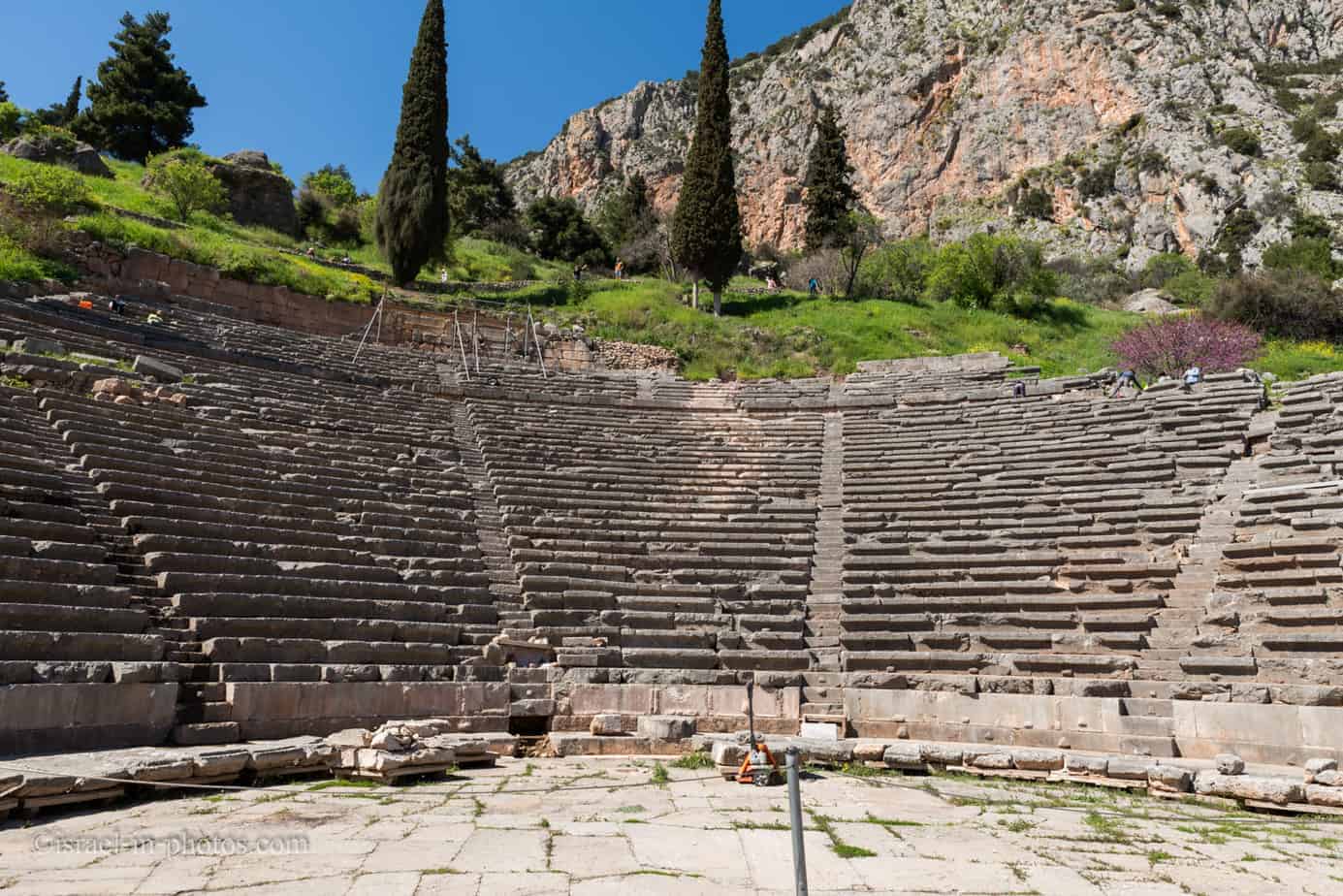
Overlooking the Temple Of Apollo and the valley:
We were running out of time, and at this point started our decline back to the entrance.
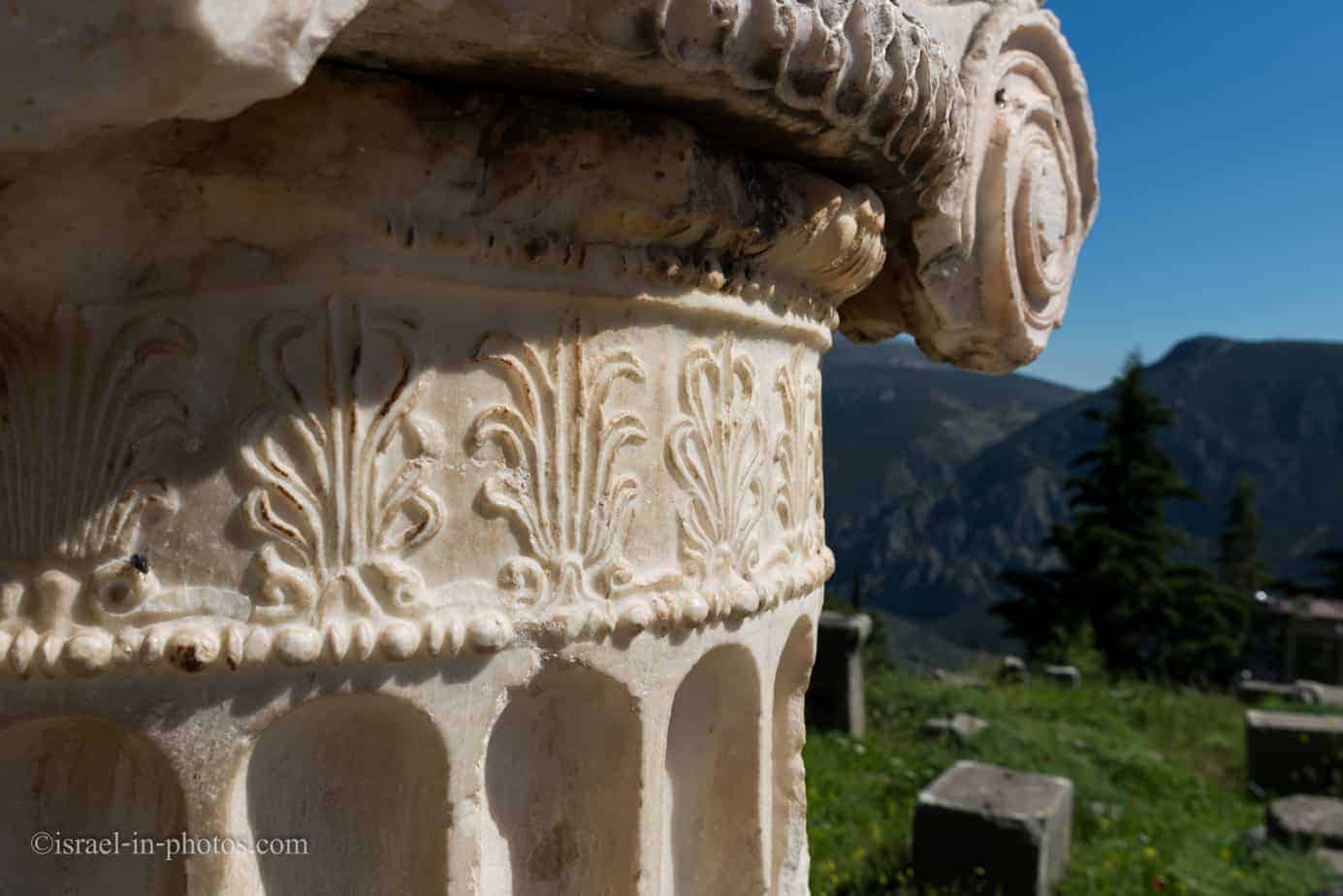
Another view of the Treasury Of The Athenians: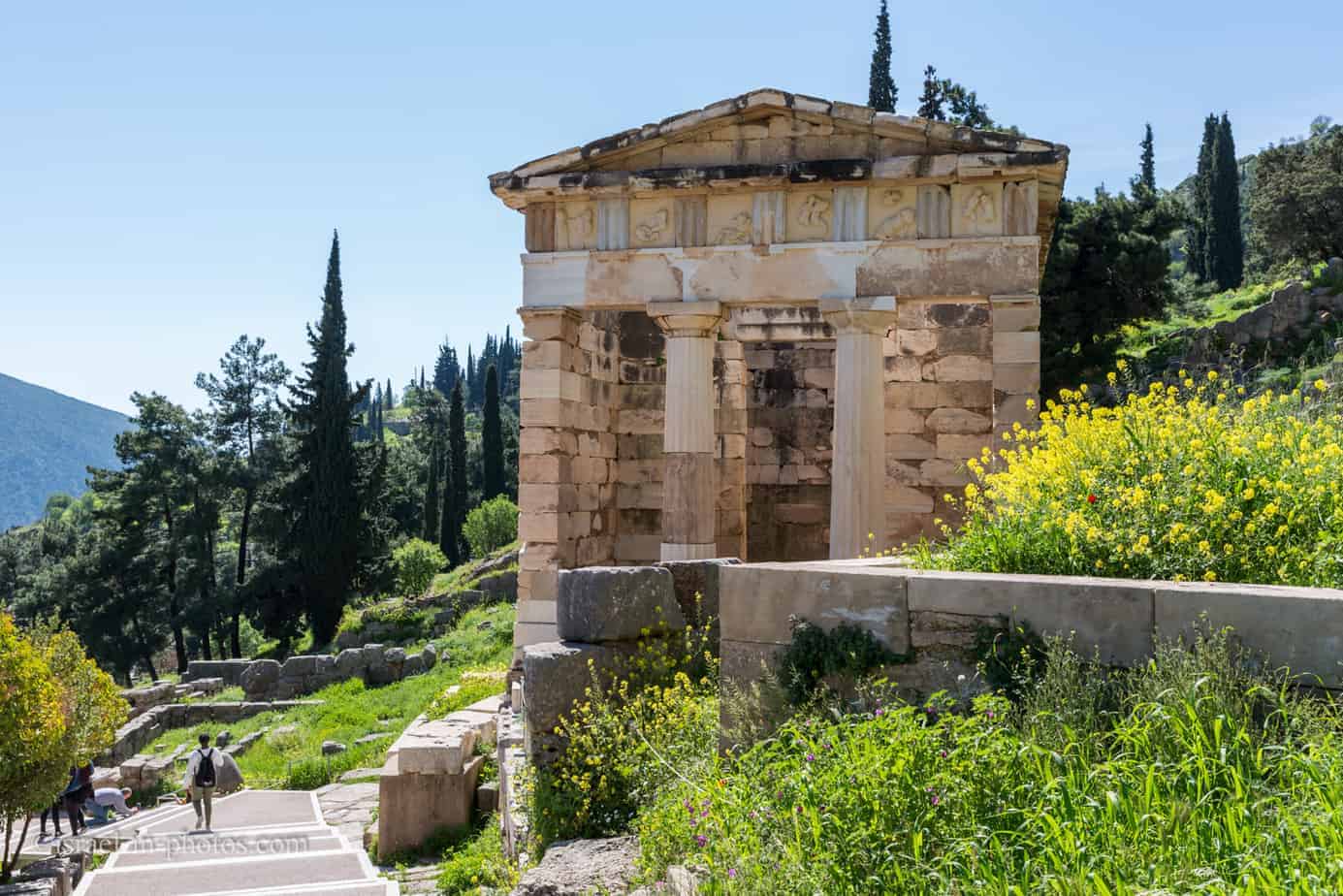
One hour was not enough to cover the Sanctuary Of Apollo, but we were able to visit the most important sites.
Museum Of Delphi
As we headed to the museum, we understood that we were not the only ones on a tight schedule. Crowds poured from Sanctuary Of Apollo to the museum, and it created a traffic jam. Fortunately, the museum is not a big one and you can cover it within an hour (though not very thoughtfully). Here is a map of the museum:
As you can see it was crowded.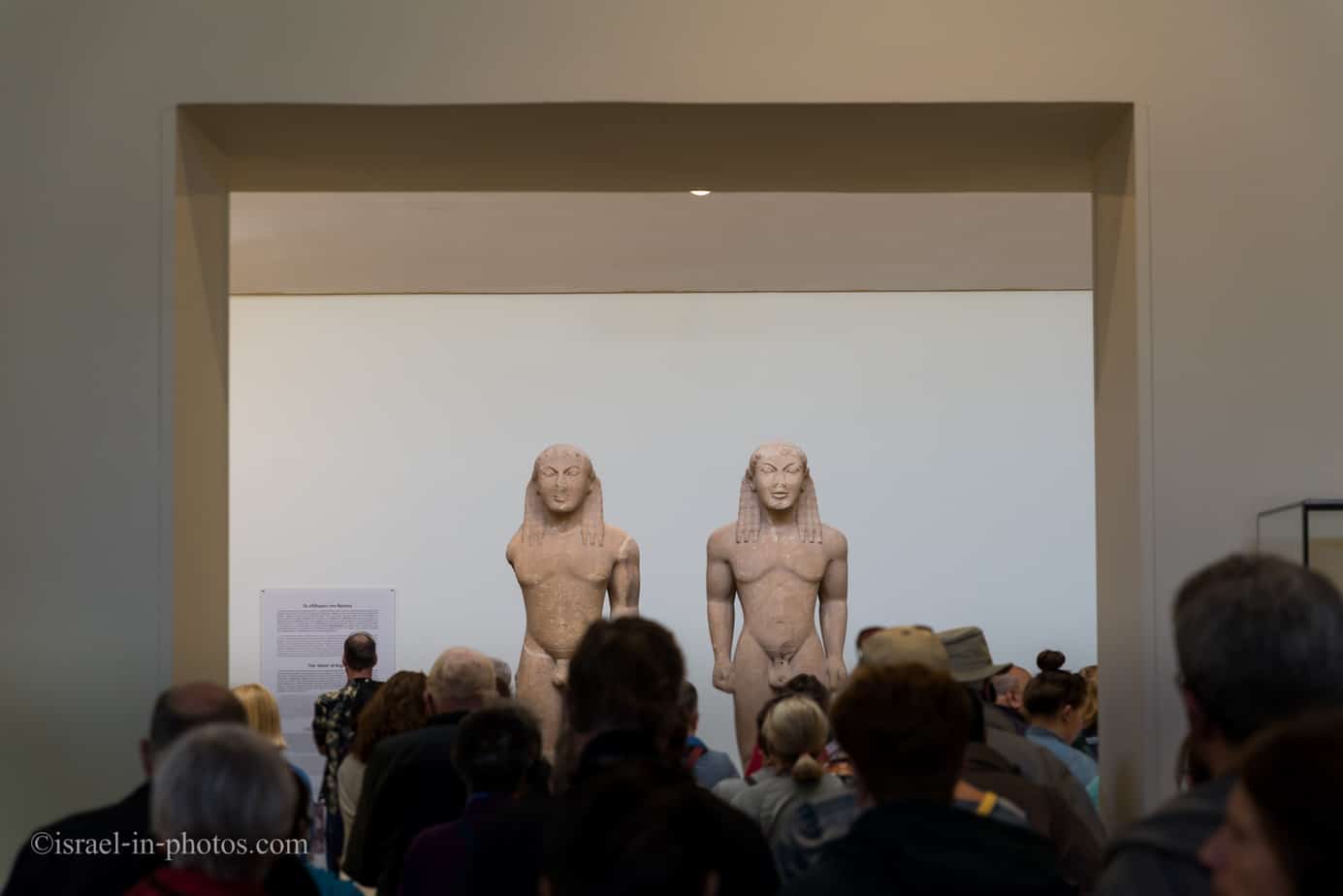
Greek friezes:
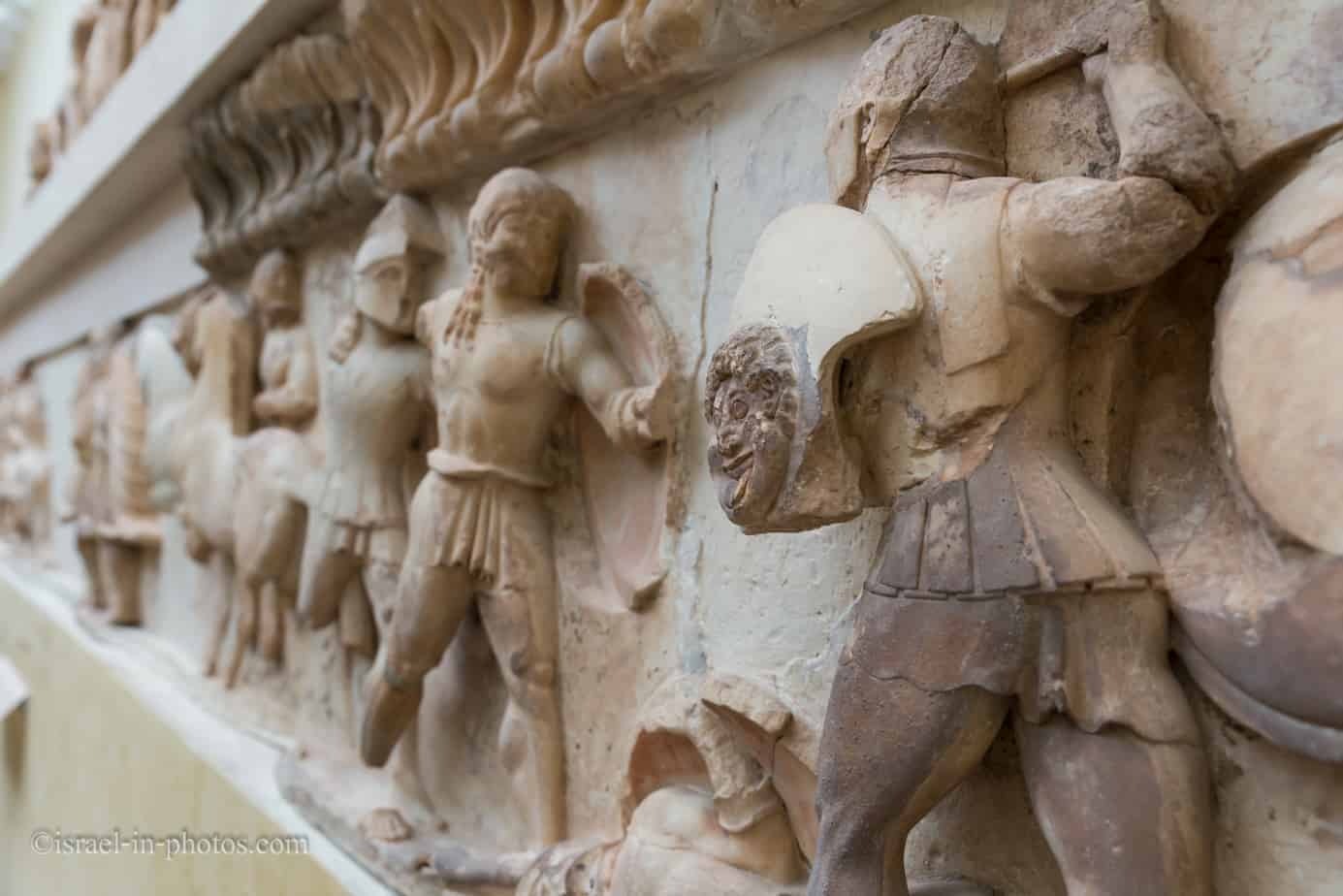
In about 560 BC, preceding the construction of the luxurious Siphnian treasury, Naxos sends a grandiose offering to Apollo of Delphi. The statue of the mythical Sphinx.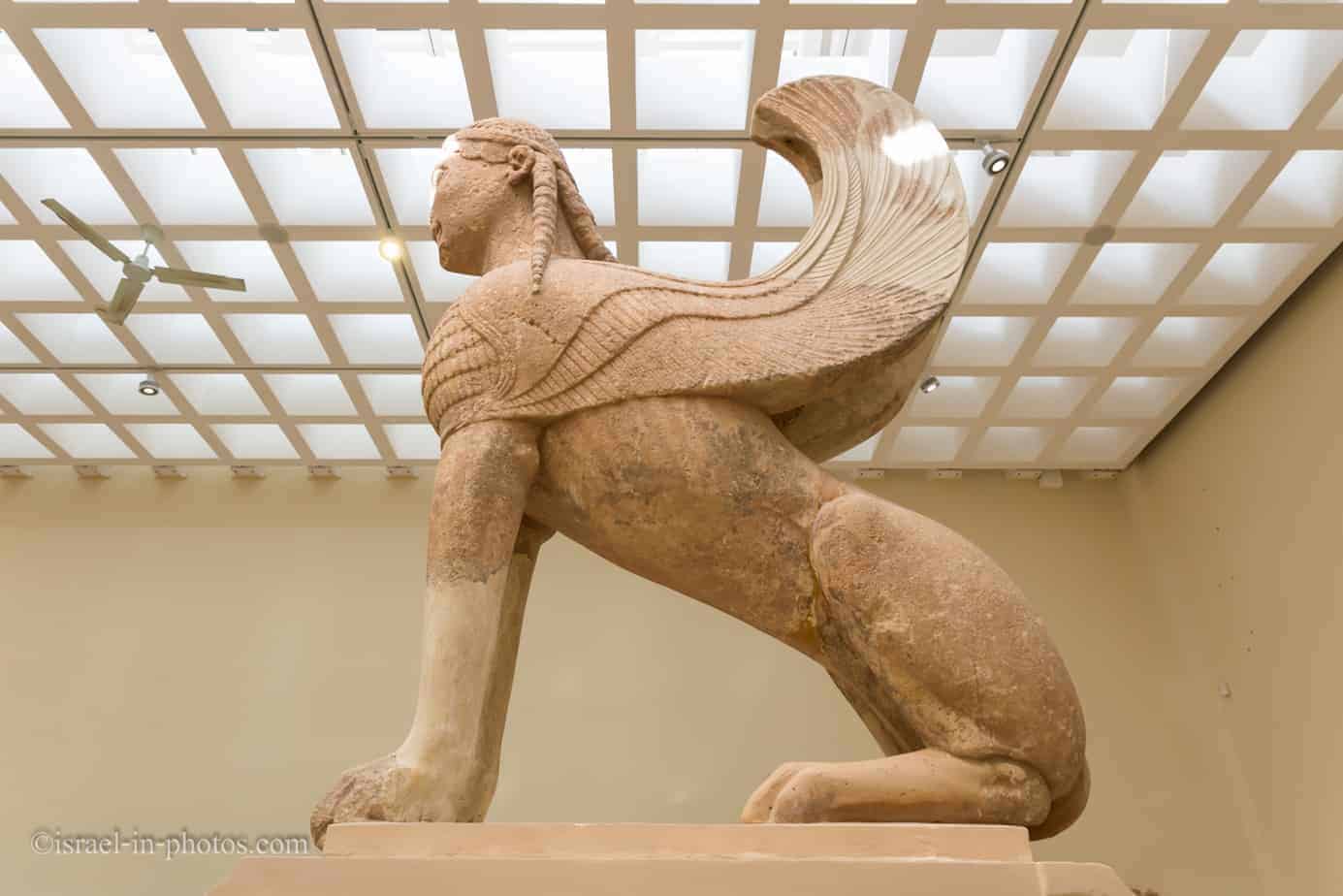
Representation of the sanctuary of Apollo by A. Tournaire: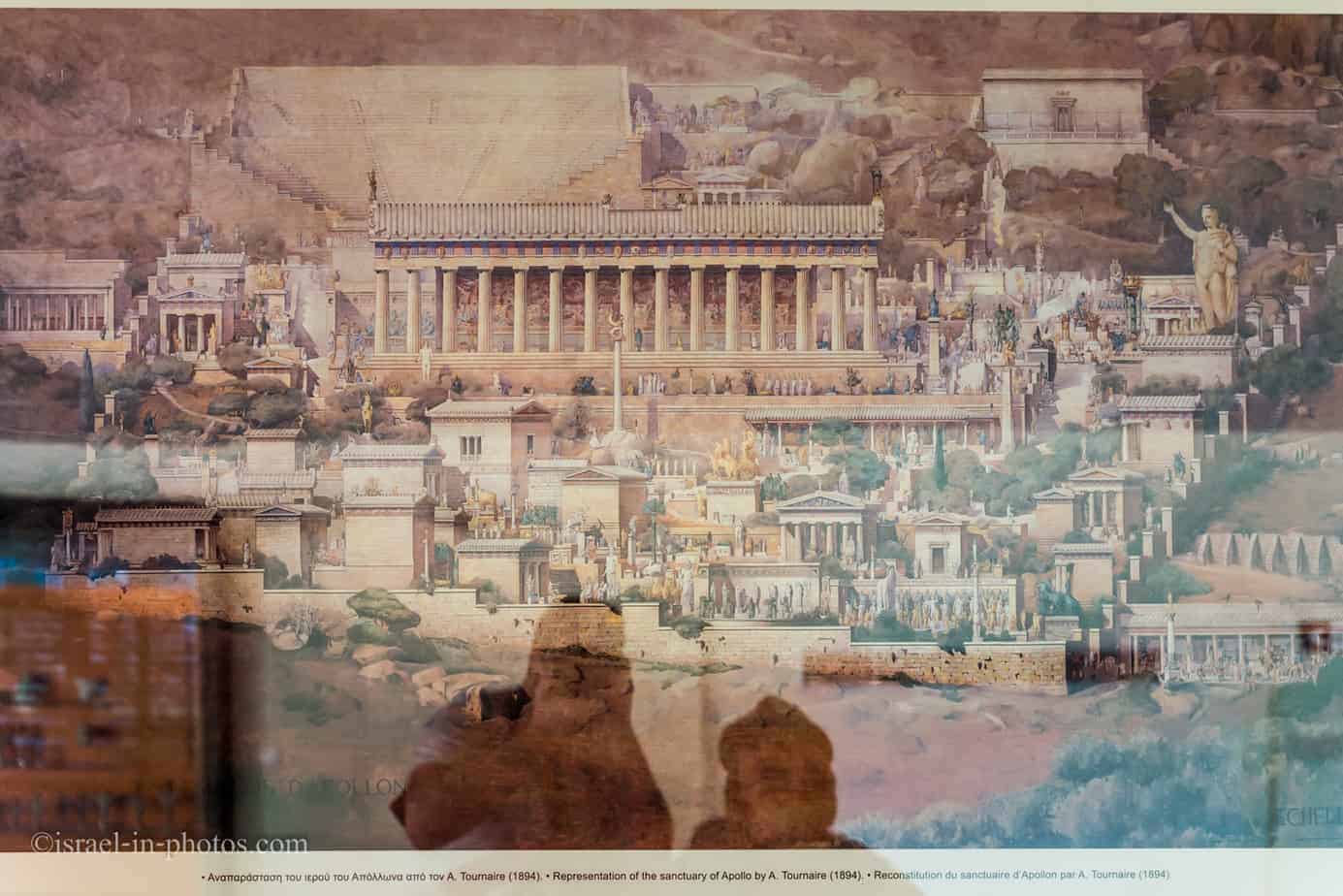
Sanctuary Of Athena Pronaia
From the museum, we headed to the Sanctuary of Athena Pronaia. It is located about 1.5 km from Sanctuary Of Apollo.
In the Sanctuary Of Athena, the goddess was worshipped as the patroness of wisdom, fertility, and health.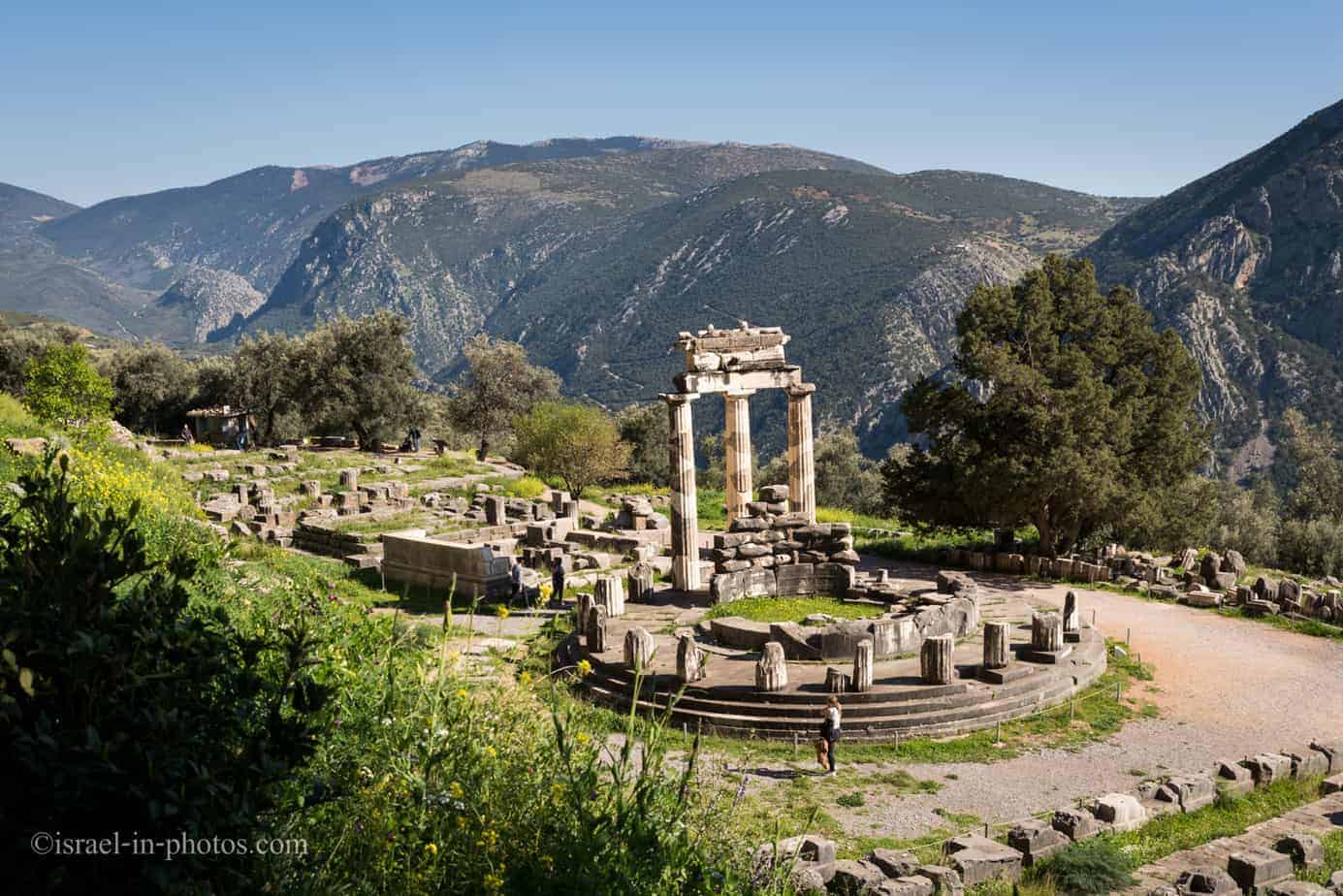
The Tholos
The round building is the Tholos of Delphi. It is considered a masterpiece due to its rich sculpted decoration, polychromy and fine craftsmanship.
The circular structure is dated to 4th century BC. It is built of marble from Mount Penteli in Attica. And the outer colonnade comprised of twenty Doric columns. Three of which were restored in the 30s.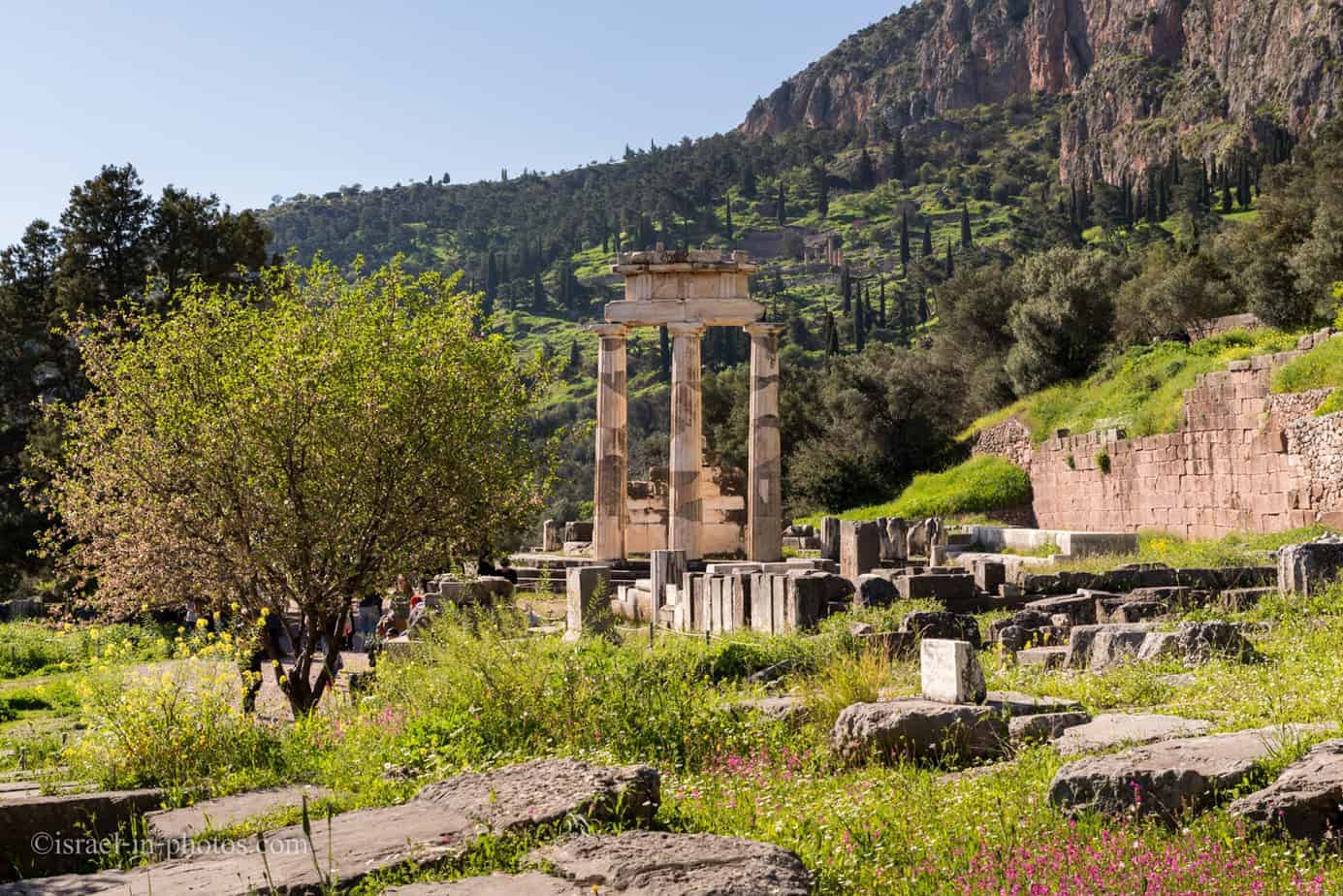
Kastalian Spring
The water of the Kastalian Spring flowed from the slopes of Phaedriada and gushed into a narrow gorge. It supplied the sacred oracle with water, which served for purification both of the priests and the faithful. Even today the Kastalian Spring continues to supply visitors with water.
Evening Walk At Delphi
From Delphi archeological site we continued to a nearby village under the same name. We checked in to the pre-booked hotel and went for an evening walk.
Itea and Kolpos Iteas:

Delphi is a nice small touristic village. The fact that small supermarkets were open till late (like 19 or 20), surprised me. Usually, in Europe, especially in smaller towns and villages everything closes at 17-18.
The main square with the church: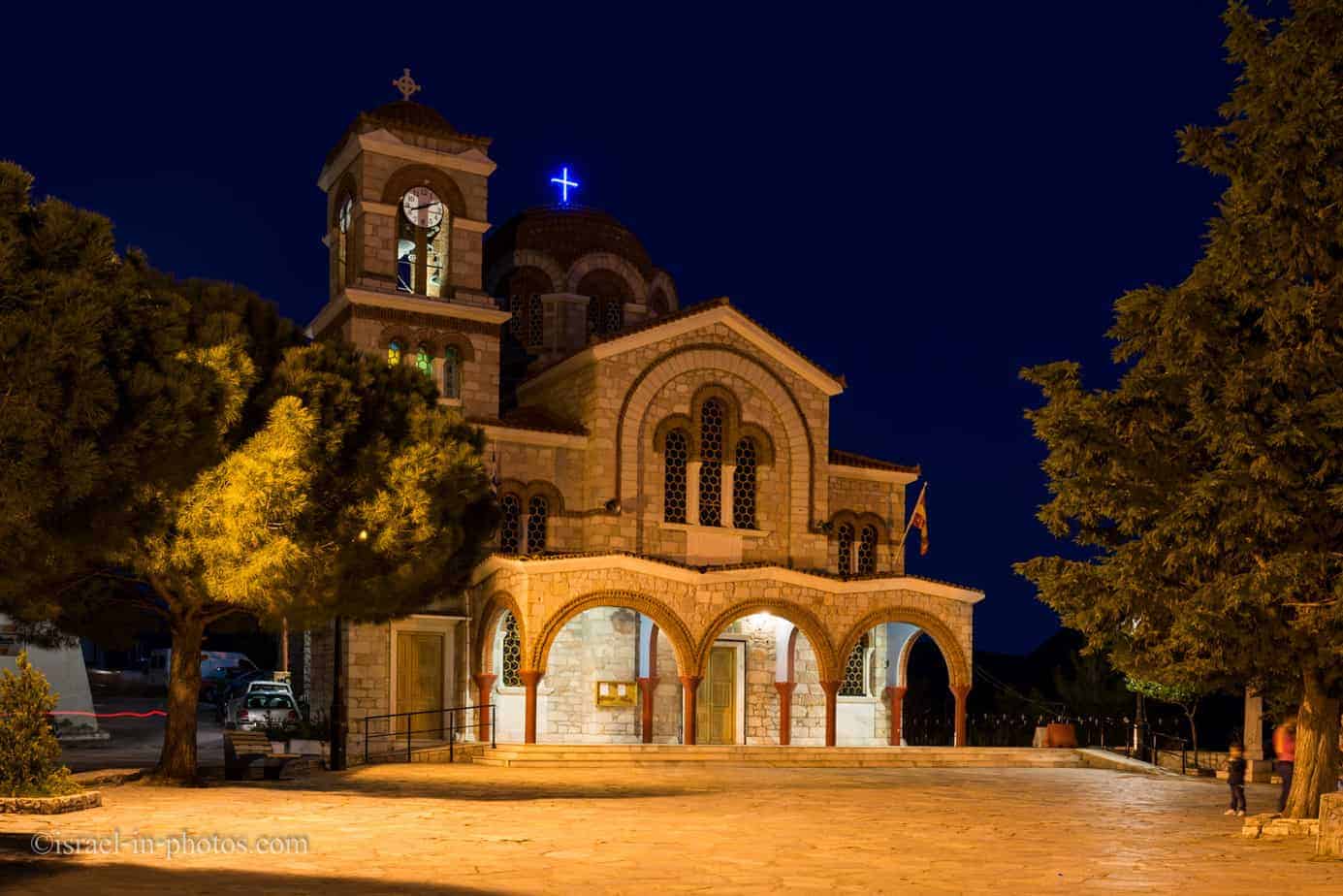
The following photo was taken almost at 9 pm and as you can see stores and cafes are open.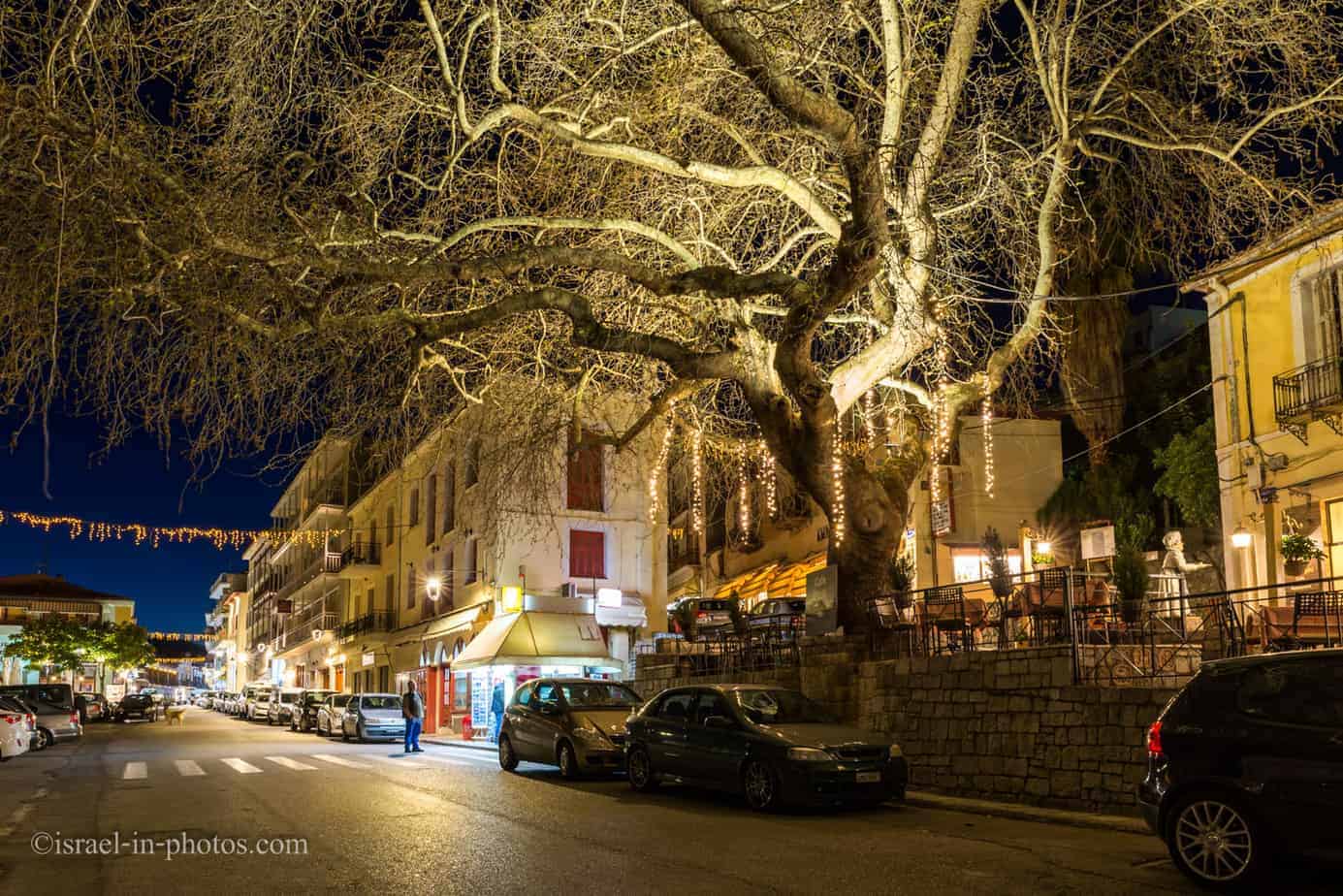
Day 2 – Corinth
We started the second day with a three-hour drive to Corinth.
Corinth Canal
The Corinth Canal connects the Gulf of Corinth with the Saronic Gulf in the Aegean Sea. It cuts through the narrow Isthmus of Corinth and separates the Peloponnese from the Greek mainland, arguably making the peninsula an island. The canal was dug through the Isthmus at sea level and has no locks. It is 6.4 kilometers in length and only 21.4 meters wide at its base, making it impassable for most modern ships. Nowadays it has little economic importance and is mainly a tourist attraction.
The canal was initially proposed in classical times, and a failed effort was made to build it in the 1st century AD. Construction started in 1881 but was hampered by geological and financial problems that bankrupted the original builders. It was completed in 1893 but, due to the canal’s narrowness, navigational problems and periodic closures to repair landslides from its steep walls, it failed to attract the level of traffic expected by its operators.
Source: Wikipedia
Ancient Corinth
From the Corinth Canal, we headed to Ancient Corinth. But on the way, as I mentioned in the introduction, we got lost with Waze. And this is on top of the fact that we were already late. We switched to Google maps, but we got to Ancient Corinth at half past two. And the park was open till 15. The cashier did not let us in, and the photos you see were made through the fence surrounding the park.

As we walked along the barrier, I noticed that we were not the only ones. Other tourists were also walking along the fence and taking photographs as well.
Background Information
Corinth was a city-state on the Isthmus of Corinth, the narrow stretch of land that joins the Peloponnese to the mainland of Greece, roughly halfway between Athens and Sparta. The modern city of Corinth is located approximately 5 kilometers northeast of the ancient ruins. Since 1896, systematic archaeological investigations of the Corinth Excavations by the American School of Classical Studies at Athens have revealed large parts of the ancient city, and recent excavations conducted by the Greek Ministry of Culture have brought to light important new facets of antiquity.
For Christians, Corinth is well-known from the two letters of Saint Paul in the New Testament, First Corinthians and Second Corinthians. Corinth is also mentioned in the Book of Acts as part of the Apostle Paul’s missionary travels. Also, the second book of Pausanias’ Description of Greece is devoted to Corinth.
Ancient Corinth was one of the largest and most important cities of Greece, with a population of 90,000 in 400 BC.[1] The Romans demolished Corinth in 146 BC, built a new city in its place in 44 BC, and later made it the provincial capital of Greece.
Source: Wikipedia
Apollo Temple in Doric style:

Ancient Corinth is located in Archea Korinthos. It is a small village with cafes and a small church.
We tried to enter it, but the church was closed.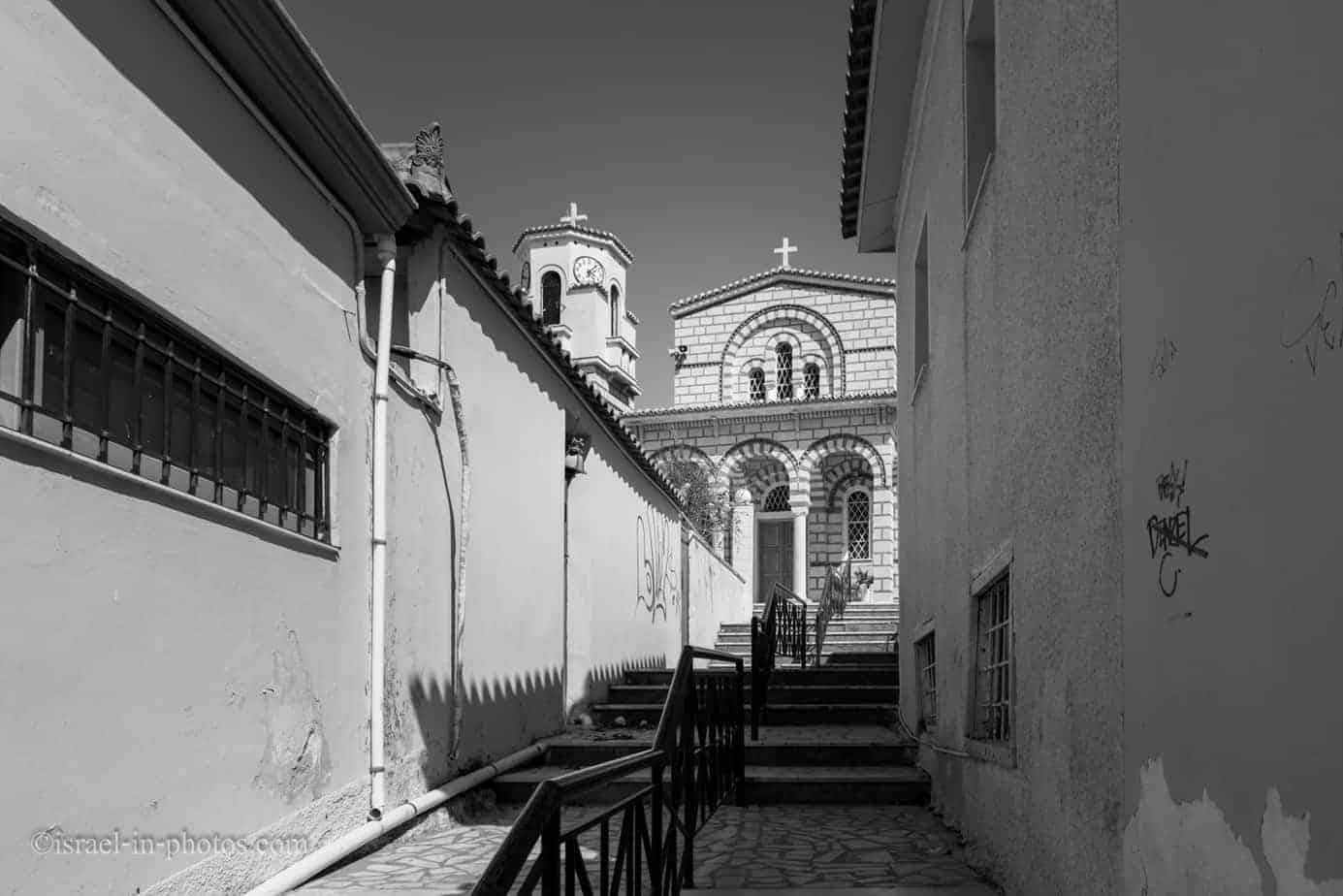
We spend the rest of the day at Loutraki. Mostly we enjoyed the beach and the featured image of this post (sunset at the seashore) was taken there while having an evening stroll at Loutraki.
Day 3 – Archaeological Site Mycenae And Others
Archaeological Site Mycenae
We started the third day with a visit to the archeological sites of Mycenae and Tiryns.
Background Info
The archaeological sites of Mycenae and Tiryns are the imposing ruins of the two greatest cities of the Mycenaean civilization, which dominated the eastern Mediterranean world from the 15th to the 12th century B.C. and played a vital role in the development of classical Greek culture. These two cities are indissolubly linked to the Homeric epics, the Iliad and the Odyssey, which have influenced European art and literature for more than three millennia.
Source: unesco.org
Citadel Of Mycenae
Mycenae built between two hills. Profitis Ilias and Sara. According to myth, Mycenae was founded by Perseus, son of Zeus and Danae. In order to build the citadel, Perseus employed Cyclopes, after whom the fortification walls were dubbed cyclopean.
We followed the paved path that leads through the Citadel Of Mycenae. And the first thing we saw was the Lion Gate.
Lion Gate
The Lion Gate is the main entrance to the Citadel Of Mycenae. The monolithic threshold, lintel, and jambs are of a conglomerate. The relief of the lions masks the ‘relieving triangle’ left above the lintel. It is the oldest monumental relief in Europe. Unfortunately, the heads of the lions have not survived. The gate dates to approximately 1240 BC, it is contemporary with the second building phase of the citadel.

Grave Circle A
Just after the Lion Gate, you can find the Grave Circle. It forms part of an extensive cemetery of the Middle Helladic and the early Late Helladic period. This graveyard was used exclusively for royal burials during the 16th century BC. The luxurious grave goods are exhibited in the National Archeological Museum at Athens.
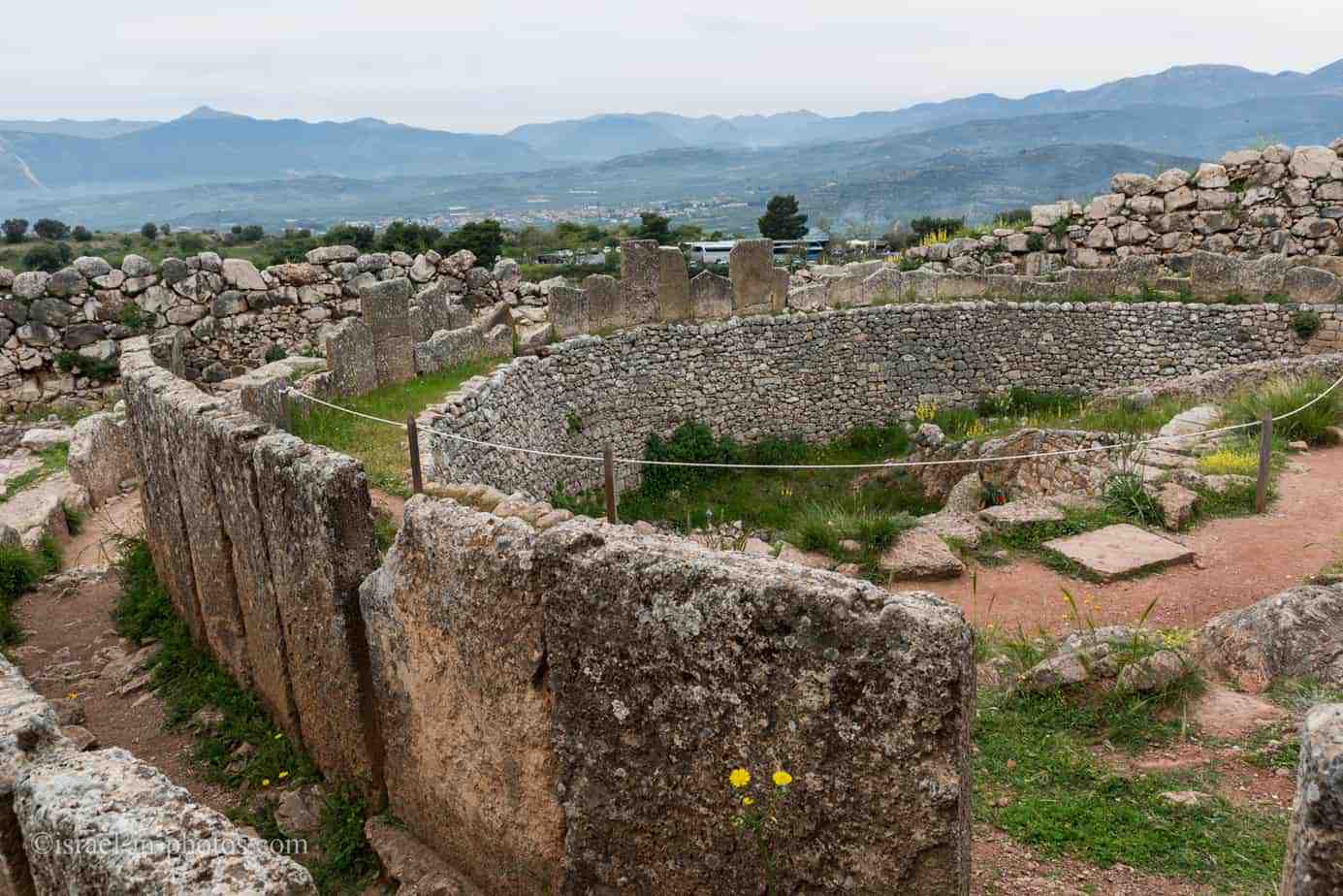
Figs:
Here you can see the parking. Buses and cars are parked in the same place. From there you go through the entrance (under the trees on the right) and start the route. The Lions Gate is to the right, and from there the citadel trail continues to climb spirally.

The Citadel has many POI, but I will not go over all of them.
The North gate was constructed during the second building phase of the walls (around 1250 BC). Four monolithic blocks of almond stone form the two jambs, the lintel and the threshold. And instead of a relieving triangle, it has two plain, vertical slabs set on the edge above the lintel.
Lion Tholos Tomb
The trail from the North gate leads to Lion Tholos Tomb.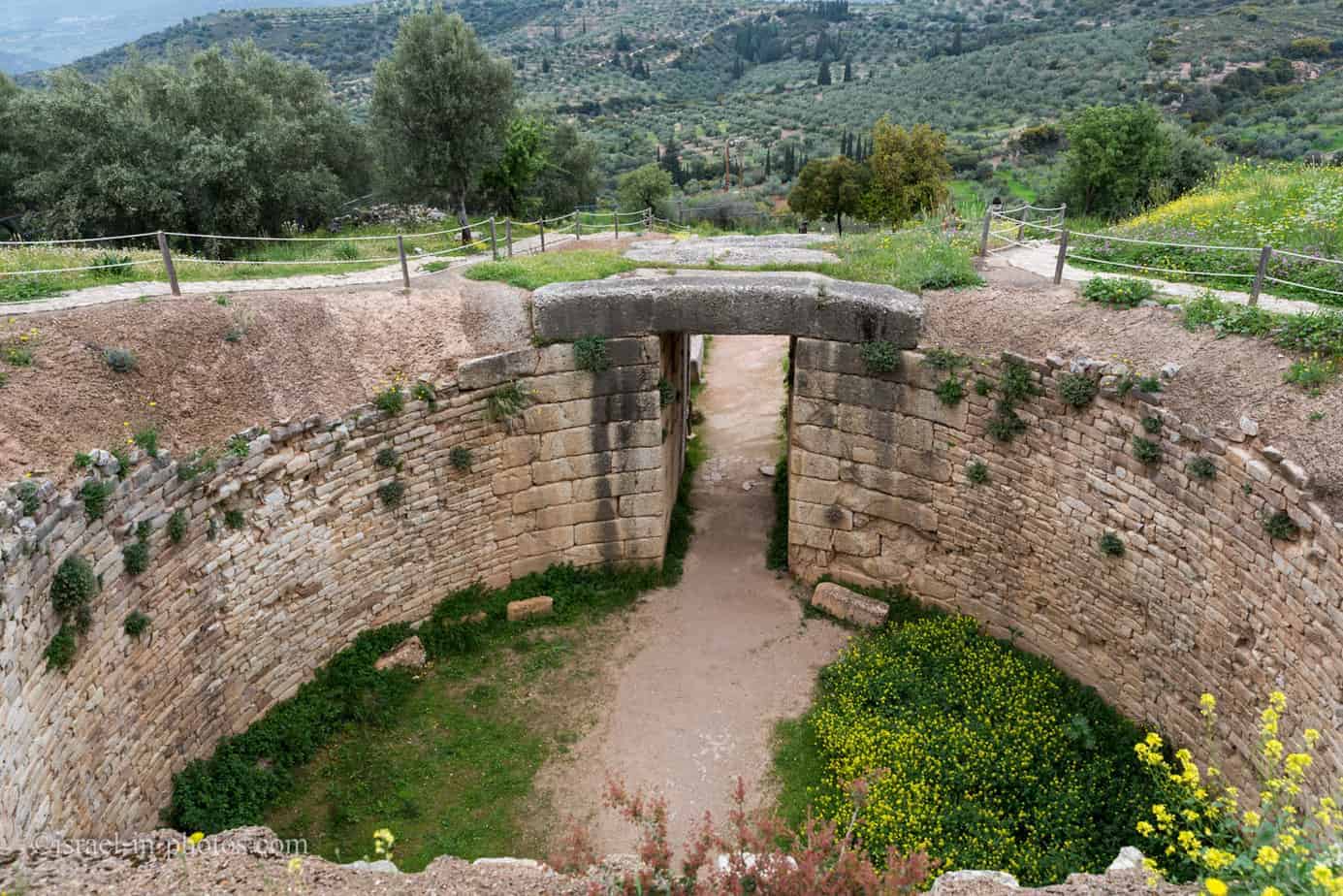
A tholos or ‘beehive’ tomb, received its name due to its closeness to the Lion Gate. By its form and construction, it is dated to the early 15 century BC. The long passage is revetted on both sides by ashlar poros blocks. Its entrance is covered by four monoliths, and the external one has two holes. It means there were doors.
The tholos jas not survived, but is estimated to have been about 15 meters high.
Mycenae Museum
Our next stop was the museum. As we entered, we saw a model of the citadel.
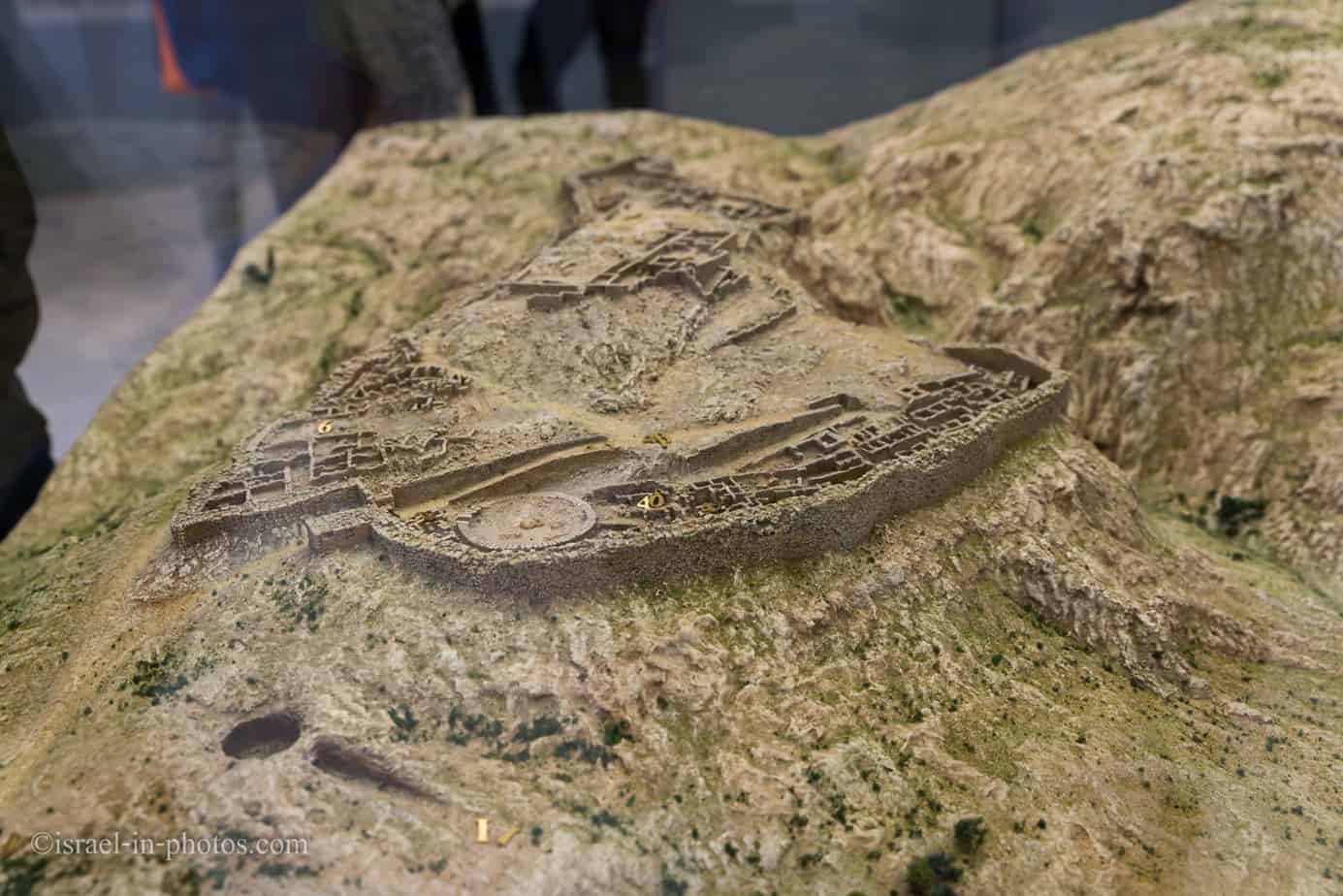
Development of figurines: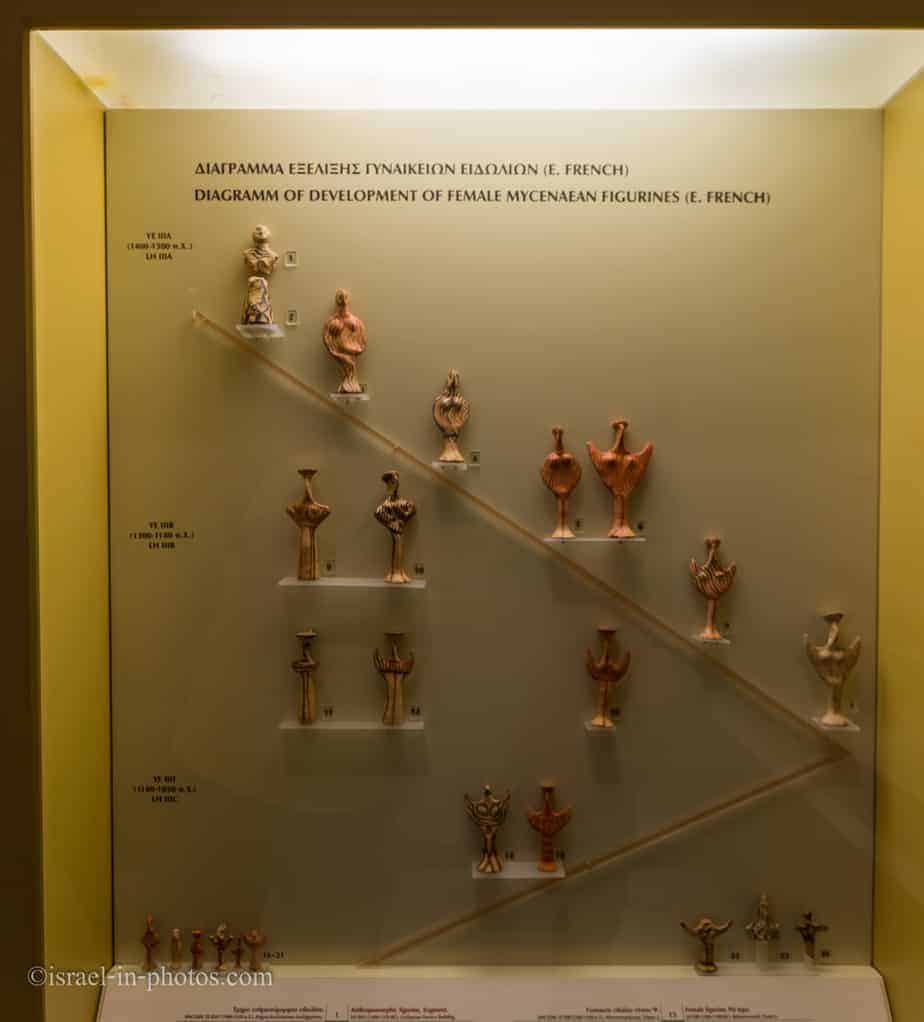
If you look closer at some of the vases, then you see they are actually not a single piece. There are many parts and recreating the original vase is a masterpiece by itself.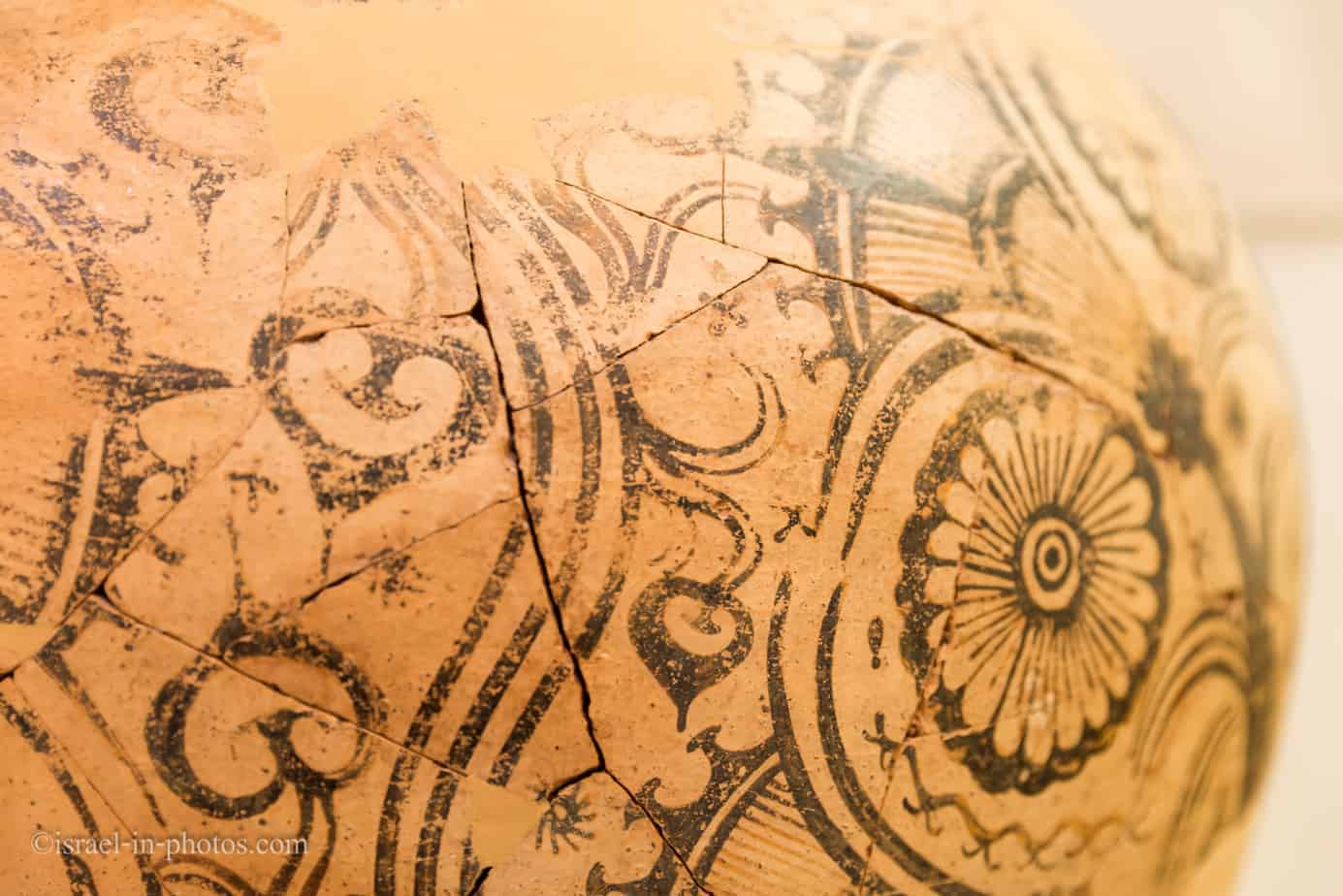
Mask of Agamemnon
The gold funeral Mask of Agamemnon is probably one of the most important findings in Mycenae. But, this is not the original. The original is in Athens, in the National Archaeological Museum of Athens.
The discovery of Grave Circle A in 1876 by German archaeologist Heinrich Schliemann amazed the world with its momentous finds. The tombs in Grave Circle A contained nineteen burials. The wealth of the grave gifts reveals the high social rank of the deceased. The pottery finds dates to 16th to 15th centuries BC.
Heinrich Schliemann believed that he had found the body of the Mycenean king Agamemnon, leader of the Achaeans in Homer’s epic of the Trojan War, the Iliad. But modern archaeological research suggests that the mask predates the period of the legendary Trojan War by about 300 years.
When I saw this round stamp, it reminded me of a visit to Tel Hazor National Park And Hazor Antiquities Museum. Hazor Antiquities Museum also has similar round stamps. And when I rechecked my post, I saw that Hazor traded with Mycenae. I guess it is true when some archeologist say that globalization started many centuries ago.
The museum was lovely and quite small. We spent around an hour there and continued to last POI at Mycenae.
Treasury Of Atreus
The tholos or ‘beehive’ tomb dubbed the ‘Treasury Of Atreus’ is one of the most splendid monuments of Mycenaean architecture. It was built between 1350 and 1250 BC. It consists of a passage, entrance, vaulted chamber and a small side chamber. The monumental facade was decorated with a variety of materials. Parts of the sculptured decorations are in the British Museum and the National Archeological Museum, Athens.
The tomb was found robbed, like all tholos tombs, and there is no information regarding grave goods or the burials it once hosted. The tholos was never buried by earth, thus it attracted the attention of people.
Inside:
Ancient Nemea
We finished at Mycenae around half past one. Since by this point we knew that all archeological sites close at 15:00, we decided to check if there is something nearby. Ancient Nemea is both close and has good reviews. Thus, we drove there.
Archaeological Site of Nemea is divided among several spots. We did not have time to visit the stadium of Nemea. Thus we drove straight to Temple of Zeus.
Background
Nemea is a land of legends and traditions. It was the homeland of the Nemean Lion, slayed by the legendary Hercules. The Nemean lion was a vicious monster that lived in a cave on mount Triton. Hercules trapped the beast and then killed it with his club.
The archaeological site is located on the foothill of the mountains of Arcadia, 333 meters above sea level. The strategic location of Nemea and its climate were the reason that the Panhellenic Games of Nemean were held in the region. During the winter, the region was turned into a swamp, during the summer though it was the ideal place to practice sports. The most significant monuments of Nemea are the temple of Zeus and the Stadium. Since Nemea did not have residents, the management of the games belonged initially to Cleonae and then to Argos.
Source: mythicalpeloponnese.gr
We started our visit with the small museum on site. Here is a modern model of this site.
Bath complex on site:
Temple of Zeus
The centerpiece of the Macedonian building program was the Temple of Nemean Zeus, three columns of which have always stood since the time of their original construction. (It should be emphasized that Nemean Zeus is not the same as Olympian Zeus. The latter is the fulminating philandering king of the gods; the former is the god of shepherds and shepherding, a reflection of the condition of the valley as unsuitable for cultivation, but useful for grazing.)
The temple stands at the end of the Classical Doric temple tradition and the beginning of the new Hellenistic combination of architectural forms with an increased emphasis on decoration. It has a shorter plan, with six columns across the ends and twelve on the sides (the Classical proportion would have been 6 x 13), and it lacks the back room or opisthodomos which is a characteristic of the older tradition.
Source: nemeangames.org
Though the visit to Archaeological Site of Nemea was a short one, it was charming.
As you noticed by now, we visited many archeological sites. We wanted to visit something that our daughter would truly enjoy. And since she loves art, we drove to Silo Art Factory.
Silo Art Factory
Silo Art Factory has a small compound not far from Mycenae and Nemea. In this compound, you can find a small cafe and big ceramics store. And in the back of the shop, there is a workspace for ceramics workshops.
It is quite easy to spot Silo Art Factory. As you drive along the road, you will see this metal horse. Once you see it, park nearby.

In the store.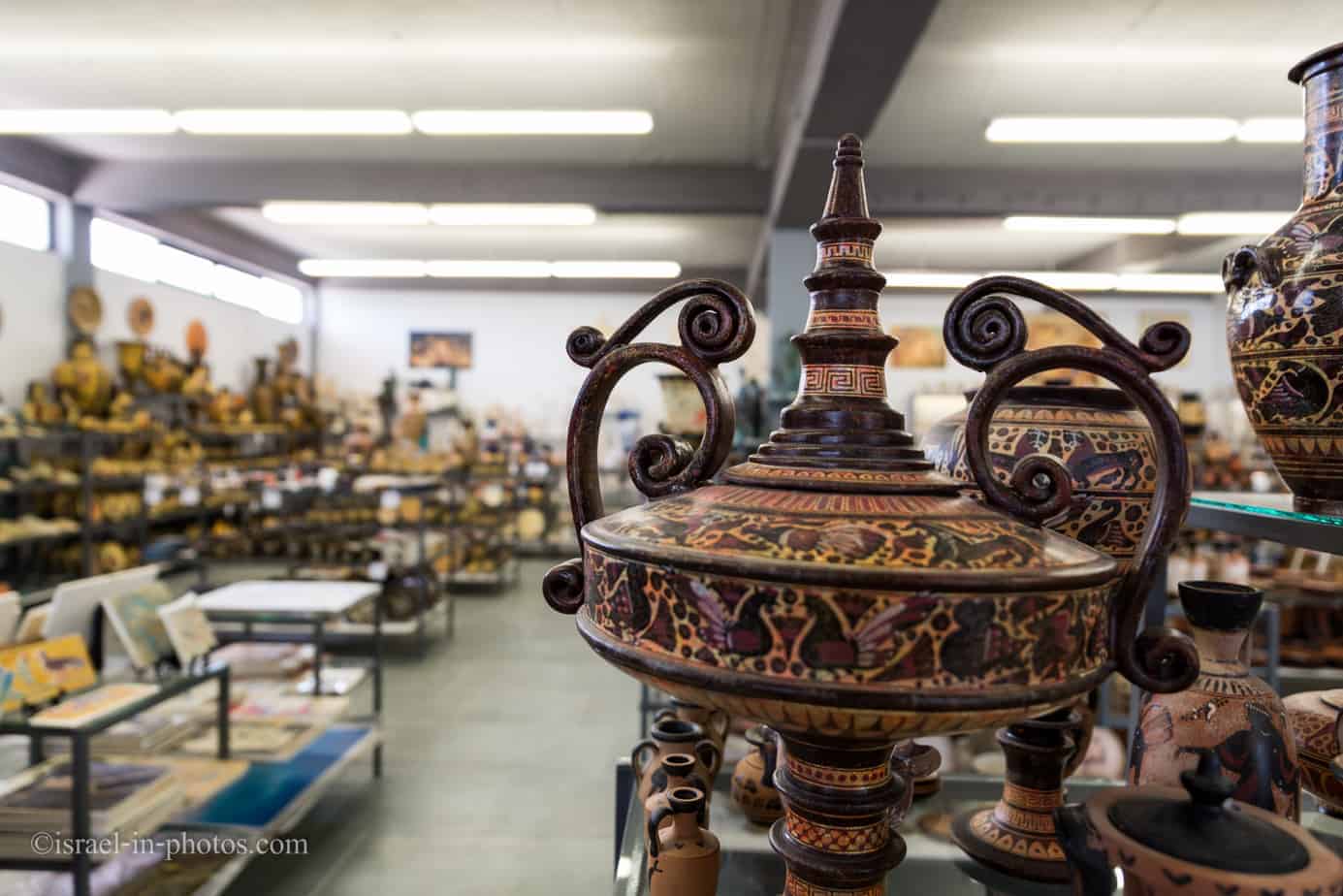
We decided to take ceramics workshops for my daughter. But, the workshops are not limited to children, and actually, we saw there a group of only adults.
The price was 20 Euro for one hour workshop.
A guide sat with us during the whole workshop and after initial explanations, my daughter started to craft. And this cat mug was the final result.
They use a particular type of clay. You do not need to put it inside an oven. Instead, it needs to dry for several weeks.
Unfortunately, the mug did not make it in one piece back home. But the whole experience was delightful, and my daughter loved it.
Summary
As you can see Greece has a variety of things to offer. The attractions were good, the food was great, and the service was of a high standard. The only downside was the early (15:00) closure of national parks. But even that did not spoil our vacation. So, go on and visit Greece!
Also, I want to repeat the fact that we visited during the end of March and beginning of April. That is a less touristic and cooler season. Thus, if you come in August, you might get a worse experience.
Join us for the second part, where we visit Athens.
Have you ever been to Greece? Tell us about your experience in the comments below.
That’s all for today, and I’ll see you in future travels!
Stay Tuned!
Additional Resources
Here are several resources that I created to help travelers:
- Trip Planner with Attractions and Itineraries is the page that will help you create your perfect travel route.
- What is the Best Time to visit Israel? To answer this question, we will consider the weather, prices, holidays, festivals, and more.
- Information and Tips for Tourists to Israel will answer the most common questions tourists have about Israel (including safety, passports, weather, currency, tipping, electricity, and much more).
- Israel National Parks and Nature Reserves include a complete list, top ten, map, tickets (Israel Pass, Matmon, combo), and campsites.
- If you are looking for things to do, here are the pages for Jerusalem, Tel Aviv, Haifa, Sea Of Galilee, Akko (Acre), Eilat, Nazareth, Safed (Tzfat), and Makhtesh Ramon.


